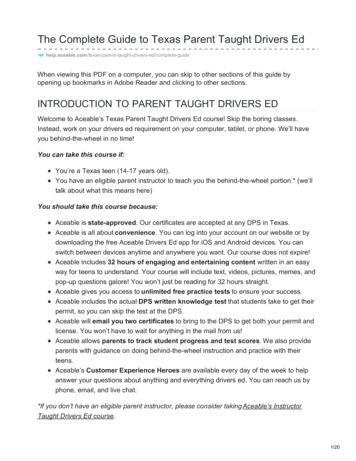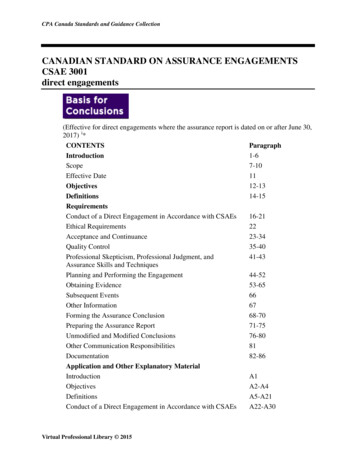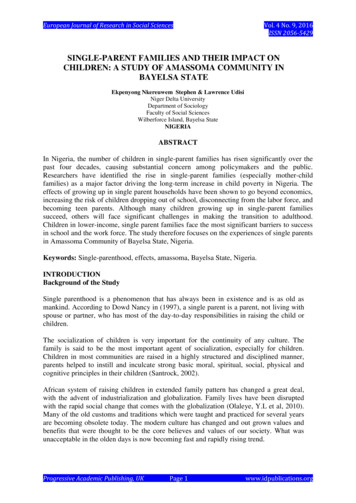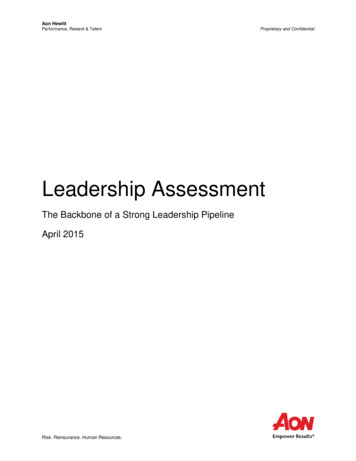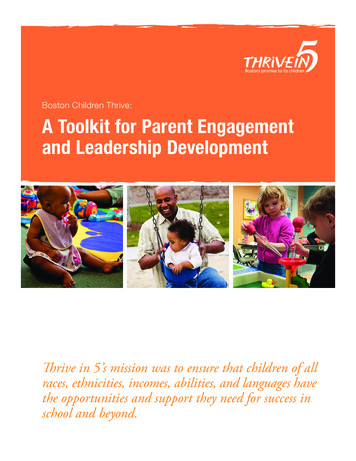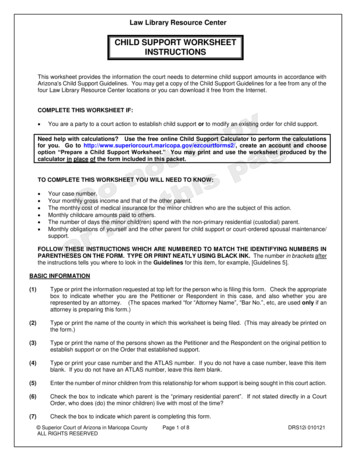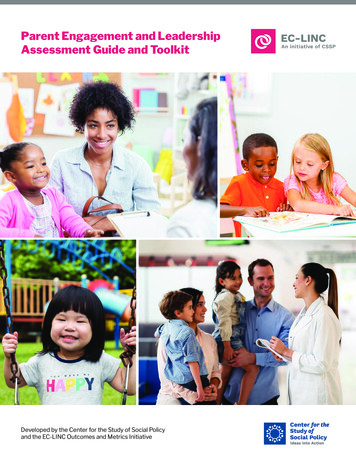
Transcription
Parent Engagement and LeadershipAssessment Guide and ToolkitDeveloped by the Center for the Study of Social Policyand the EC-LINC Outcomes and Metrics Initiative
ContentsAcknowledgementsIntroduction 02Assessment Guide 03Understanding the Framework05Frequently Asked Questions 07Parent Engagement and LeadershipAssessment Tool: Abridged Version 08Parent Engagement and LeadershipAssessment Tool Comprehensive Version14Parent Engagement and LeadershipAssessment Tool: Questions for Grantmakers,Policy Advocates, and Capacity-Builders 23Appendix A: Discussion Guidefor Analyzing Results 27Appendix B: Gathering Data onParents’ Experience 28Appendix C: Sample Action Plan 29This assessment tool builds upon and amplifies a number of terrific tools,reports and articles, including:The Annenberg Institute for School Reform at Brown University: The FamilyLeadership Self-Assessment Rubric: An Indicator Tool for School Districts andLessons from Central Falls, Rhode IslandLucile Packard Foundation for Children’s Health: A Framework for Assessing FamilyEngagement in Systems ChangeNational Center for Parent, Family and Community Engagement: Using the HeadStart Parent, Family, and Community Engagement Framework in Your Program:Markers of ProgressThe Annie E. Casey Foundation: Engaging Parents, Developing Leaders: A SelfAssessment and Planning Tool for Nonprofits and SchoolsFAST: Families and Schools Together: Measuring the Effectiveness of ParentEngagement InitiativesUniversity of Washington Department of Education: Towards Equitable ParentSchool Collaboration: Developing Common Parent Engagement IndicatorsRace Matters Institute: Racial Equity Organizational AssessmentThis assessment guide and toolkit is theresult of almost a year of collaborationbetween system leaders, providers, andparent leaders in EC-LINC communitieswith dedicated leadership from MeliaFranklin as a consultant to the Centerfor the Study of Social Policy. As aresult of their commitment of time andexpertise, this tool has gone throughseveral important transformations andimprovements.The final product has benefitedimmeasurably from the input of membersof the EC-LINC Family EngagementCommunity of Practice, which includedpartners from Alameda County, CA;Boston, MA; Denver, CO; Hartford, CT; KentCounty, MI; Lamoille Valley, VT; Palm BeachCounty, FL; and Ventura County, CA.Special thanks to LaNita Sanders andDelores Haynes of Children’s ServicesCouncil of Palm Beach County, andLeticia Hernandez of First 5 Los Angeles,for providing pivotal early feedbackand involving many team members inthe process. Aditi Subramaniam of theBoston Family Engagement Network, alsoprovided vital feedback throughout thedevelopment process and took on thedaunting task of piloting the assessmentwith family centers in Boston, includingBoys and Girls Clubs of Dorchester, SouthBoston Neighborhood House, and AllstonBrighton Family Support Network.Members of the newly formed EC-LINCParent Leader Network PlanningCommittee also contributed invaluablefeedback, participating in many hours ofreview and discussion: Caroline Austin andMary Bastion-Gandelman from CatholicCharities Archdiocese of Hartford; DeenaSmitherman and Lisa Melara from BostonFamily Engagement Network; and AnthonyQueen from Great Start Collaborative ofKent County, MI.Melia Franklin developed this guide and thetools within it, with guidance and supportfrom CSSP staff members Cailin O’Connorand Stephanie Doyle.The Parent Engagement and Leadership Assessment is part of a larger Early ChildhoodSystem Performance Assessment Toolkit, which can be accessed at utcomes-metrics/.Please let CSSP know if you use any of the tools in this toolkit, and share your feedback onthem, by going to https://tinyurl.com/ECsystemperformance.Suggested citation: Parent Engagement & Leadership Assessment Guide and Toolkit. (2019).Washington, DC: Center for the Study of Social Policy.Parent Engagement and Leadership Assessment Guide and Toolkit Center for the Study of Social Policy www.cssp.org1
that in mind, we have created a menu of options so that you can pickthe starting place and the destination.Decades of research tells us that engaging familiesin their children’s learning and development is a keyfactor driving positive child outcomes. Yet, despiterecent movements to realign systems toward astrengths-based approach, families—especially lowincome families of color—face significant barriers tobeing partners and leaders in their children’s healthydevelopment and early learning.Abridged Assessment ToolFor those seeking insights on family engagement strategies thathave a more limited time and scope, we recommend the AbridgedAssessment Tool as a starting point. Engaging staff teams, crosssystem collaboratives, and parent leaders in this abridged version canbuild awareness, spark ideas, and point to areas to develop.Comprehensive Assessment ToolAgencies and systems often select engagement strategies targetedto one aspect of families’ experiences—for example, recognizing andresponding to developmental milestones—but stop short of sharingdecision-making or leadership with parents. To make the issue evenmore complex, barriers to engagement are often rooted in structuralracism and bias, which pervade the attitudes, behaviors, policies, andpractices of these systems and our society as a whole.For agencies, collaboratives, and systems ready to fundamentallyreshape the approach to engaging families, we recommend using theComprehensive Assessment Tool. Engaging multiple stakeholders—including parent leaders—the comprehensive tool can inform astrategic planning or other significant change process.Questions for Grantmakers, Policy Advocates &Capacity-buildersThis resource is designed to help agencies, systems, and collaborativesworking with young children and their families to chart a coursetoward an expanded approach to families engagement. In addition toengaging families as partners in their child’s growth and development,this approach encourages systems to partner with parents to shapea more family-centered, equitable, and collaborative system.For those agencies and systems partners whose work affectsfamilies but does not touch parents directly, these questions can helpdetermine where you can change practices and leverage influence toexpand parent leadership and engagement in the field.Whether you use this guide to stick your toes in the water or takea deep dive, we hope the experience will serve as a catalyst forconversation, planning, and action.We recognize that agencies and systems are in different phases ofdevelopment and readiness to take on change of this magnitude. WithIntroductionchildhood systems of care, including family support, children’s health,mental health, and community resources. By empowering parentsto shape systems—as decision-makers, advocates, partners, andproviders—outcomes improve for both families and systems.This assessment tool is part of an ongoing,collaborative effort to redefine how families experienceearly childhood systems and the role parents canplay to reshape these systems to be more equitable,responsive, and accountable to the families andcommunities they serve.In 2018, EC-LINC hosted a two-day convening of 40 staff and parentleaders from nine communities to discuss a central theme emergingfrom the Ripples—the interplay between race equity and parentleadership, and engagement. Over two intense days in Oakland, CA,participants hammered out the basis for a Manifesto for Race Equityand Parent Leadership in Early Childhood. The Manifesto outlines avision, goals, and strategies for transformation so that all parents aresupported and empowered to give their children a strong start in life.History and ContextIn 2016, EC-LINC, a collaboration of early childhood leaders fromacross the country supported by CSSP, developed a new frameworkand toolkit to redefine parent engagement in early childhood.that stretched beyond current definitions and paradigm of familyengagement in early childhood. The toolkit, entitled Ripples ofTransformation: Families Leading Change in Early Childhood Systemsidentifies family engagement as not only central to children’s earlylearning and healthy development, but also a core strategy toadvance equity and community empowerment.What follows is a companion tool to the Ripples and the Manifestointended to strengthen the ability of early childhood stakeholders toassess agency and system readiness to engage parents as partnersand leaders to transform systems.What is the purpose of this self-assessment?Ripples of Transformation expands the concept and practice offamily engagement from a separate strand of programming toan integrated, continuing stream of opportunities for parents tobe leaders in their families and communities, as well as in policiesand systems. It extends parent engagement from the preschoolclassroom, where most resources have been focused, into earlyWe believe that those most affected by a problem should be at theheart of creating the solutions. The overarching purpose of this tool isto support agencies and systems to engage parents as partners andleaders to advance a more equitable, accountable, and responsiveearly childhood system of care. Using this self-assessment as astarting point for dialogue and planning, agencies and systems—inParent Engagement and Leadership Assessment Guide and Toolkit Center for the Study of Social Policy www.cssp.org2
staff-family interactions, but also in agency-wide culture, operations,leadership, policies, and processes.collaboration with parent leaders and other community-basedstakeholders—will: Identify current strengthsWho should use this self-assessment? Target areas for developmentWe believe that any agency or system that significantly impacts thelives of children and their families should strive to engage parentsat all levels—from identifying issues to implementing solutions.Whether your agency impacts families by providing direct servicesor by influencing the field as a funder, policy advocate, or capacitybuilding intermediary, this self-assessment can guide your effortsto meaningfully engage with parents as partners and leaders. Forexample: Increase collaboration Plan targeted actions Measure progress toward goals.What do we mean by “parents”?We believe agencies and systems must welcome, include, respect,and meaningfully engage any adult that matters to a child. For thesake of simplicity and the prevailing views of parent leaders involvedin creating the Manifesto, we use the umbrella term “parents”to describe the full spectrum of family structures: birth parents,adoptive parents, single mothers, single fathers, non-custodialparents, incarcerated parents, LGBT parents, foster parents,grandparents, and other relative caregivers (uncles, aunts, oldersiblings) and non-relative caregivers. Direct service agencies can deepen parent engagementefforts at the program level and integrate parents into agencywide decision-making. System leaders and collaboratives can use the tool to identifywhere the system supports parents as partners and leadersand where it creates or maintains barriers. Funders and other influencers can begin or expand effortsto engage parents in shaping agency priorities, as well asinfluence and build the capacity of grantees or partners toengage parents in meaningful ways.What makes this self-assessment unique?This self-assessment, like the Ripples toolkit and the Manifesto,builds on the groundbreaking work of Strengthening Families, whichat its heart is about changing how service providers interact withfamilies to support them in building protective factors. While thisself-assessment overlaps to a degree with Strengthening Families,it additionally seeks to elevate the leadership and power of parentsand increase the accountability of systems to the families andcommunities they serve. By engaging families on multiple levels,agencies can more deeply understand the barriers families face—especially families of color—in their day-to-day interactions withsystems and work to eliminate these barriers.Where should we start?The goal of this self-assessment is to support agencies and systemsto integrate parents as partners, leaders, and advocates across allagency programs and operations. However, we recognize that invery large agencies, it might not yet be possible to include the entireagency in the process. In this case, we recommend starting with staffteams and stakeholders at the program level. After analyzing results,we encourage program teams to present findings to agency leadersto begin conversations about integrating successful strategies.Another significant difference is that this self-assessment is intendedto stimulate change not only on the level of program delivery andSee also Frequently Asked Questions, page 7.Parent Engagement and Leadership Assessment Guide and Toolkit Center for the Study of Social Policy www.cssp.org3
Assessment GuideSTEP 1Set Intention and Select ToolSTEP 4RateWhat do you want to accomplish through the assessment process?Setting the intention will help inform which which tool you use:the comprehensive assessment or the abridged assessment. Forexample, if the intention of the assessment is to inform a strategicplanning process, the comprehensive assessment version wouldbe most appropriate. If the intention is to begin a discussionamong certain stakeholders, the abridged version would be mostappropriate.Discuss each of the four pillars and four dimensions in the tool. (SeeUnderstanding the Framework, page 4.) Make sure participantsunderstand the instructions. Since stakeholders represent multipleperspectives, each member of the team should arrive at their ownrating of 1-4.STEP 5Analyze, Interpret, and CompareInvite stakeholders to a meeting or series of meetings to discussresults. To get the most out of the results, we recommenddiscussing the following (Refer to Appendix A for a DiscussionGuide):STEP 2Identify StakeholdersDefine early childhood system leaders and representatives toparticipate in the assessment process. With the stakeholder group,affirm or revise intentions. Stakeholders should, ideally include:1. What strengths did we identify?2. What areas for development did we identify? Leadership, program management, operations, anddirect service providers3. Where was there the most agreement among stakeholders?4. Where was there the most disagreement? Parent leaders active with or knowledgeable aboutthe system or agency5. How do our findings compare to data on parents’ experience?(See Appendix B for more discussion and sample survey tool.) External partners, such as collaborative work groups,community-based organizations, or grantees.STEP 6Prioritize and Plan Action StepsSTEP 3Convene Assessment TeamDetermine what action should be taken as a result of the analysis,and record in action planning guide. Use this assessment as anentrée to a larger conversation to support system building efforts.Communities use the Action Plan template in Appendix C to helpplan next steps.Convene the group to talk through the assessment, reflect onthe results, and determine what to do next with the information/analysis. Ideally, the assessment team should meet at leastthree times: 1) to review the intention, framework, tool and theassessment process; 2) to analyze the results, and; 3) to decideon priority actions. Consider holding separate and/or additionalmeetings for parent leaders to ensure maximum accessibility.Parent Engagement and Leadership Assessment Guide and Toolkit Center for the Study of Social Policy www.cssp.org4
Understanding the Framework4-point Scale: Competencies are rated across a four-point scale:(1) Not Evident; (2) Developing; (3) Progressing; and, (4) Integrated.Drawing from Ripples of Transformation and the Race Equity andParent Leadership Manifesto, as well as many other assessmenttools, we came up with the following framework:Program vs. Agency Assessment: If you are applying the selfassessment to the entire agency or system, note that a score of 4(“integrated”) indicates it is consistent across the agency or system.If what you are assessing is strong in one program, you should mark ascore of 2 (“developing”); if it is strong across all programs, you shouldmark a score of 3 (“progressing”).4 Pillars: This tool identifies competencies across four “pillars:”family-centered, equity-driven, collaborative, and transparent.4 Dimensions: We can examine competencies in each pillar throughfour “dimensions”: the system or agency’s commitment, capacity andpractice, and the degree of influence parents have.Use the graphic below and the subsequent descriptions of each framework to familiarize the team with the key TRANSPARENTWhat does it mean?What does it mean?What does it mean?What does it mean?Agencies prioritize andchampion engaging parentsas partners and leaders as acentral strategy to achievingpositive, equitable outcomesfor children and their families.Agencies make it a priorityto understand families’experiences and break downbarriers created by systemic,institutional, and individualracism.Agencies develop strongpartnerships with parentsand parent-led organizationsto support parents to buildtheir power, develop theirleadership, and advocate fortheir children and community.Agencies ensure parentshave access to informationthat allows them to fullyparticipate and influenceagency and system-levelchange processes.What does it look like?What does it look like?What does it look like?What does it look like? Parents are valued for Agencies prioritize Agencies collaborate with Parent leaders partner in Parents representing the Parents, parent-ledtheir skills, expertise,and knowledge. Theyare viewed as beingcapable and wantingto be engaged. Parents are provided theresources and support toparticipate fully. Parents and staff worktogether to design,implement, and evaluateagency programming,policies, and practices. Parents are partners andadvocates decisions abouttheir children’s care.addressing bias, racialequity, and inclusionand build it into policies,practices, and operations.parent-led organizationsfor recruitment, training,and support of participants’leadership.diversity of the communityare welcomed, respected,and valued for their uniquecontributions.organizations, andagencies work togetherat the systems level toadvocate for betterpolicies and practices. Staff and leadership are Parents have opportunitiesculturally, racially, andlinguistically representativeof parents and caregivers.to apply their leadershipskills in community andsystems change efforts. Parents of all culturesand family structuresare included in decisionmaking.all phases of agency andsystems-level change, frombrainstorming to evaluation. Formal boards andcommittees include atleast two parent leadersand decision-makingprocesses are clearlyexplained. Key materials relatedto decision-makingprocesses are available toparent leaders in formatsand language they canunderstand in a timely way. Agency consistentlycommunicates to parentshow their engagementinfluenced decisions.Parent Engagement and Leadership Assessment Guide and Toolkit Center for the Study of Social Policy www.cssp.org5
Four ur DimensionsTRANSPARENT1. Commitment: How is the agency’scommitment to authenticallyengaging parents represented inagency communications, policies andresource allocation?2. Capacity: How has the agencyexpanded its capacity to effectivelysupport parent engagement andleadership?3. Practice: How do the agency’spractices and programmingand advocacy advance parentengagement and leadership?Four Dimensions4. Influence: How much influence doparents have in program, agency andsystem-level change and governance?Four-Point Rating ScaleCOMMITMENTCAPACITYPRACTICEINFLUENCEThe rating scale describes increasing levelsof commitment, capacity, practice and levelof parent influence for each pillar.1. Not evident: There is no evidence thatthis exists.2. Developing: Some challenges or existsin a limited way. For example, it may beevident in one program, but is not seenconsistently across the agency.3. Progressing: Shows strengths, existsin a fairly consistent way, challengesare actively being addressed. Forexample, it is evident across programsand the agency has a plan to integrateit across all departments andfunctions.Four-Point Rating ScaleNOT EVIDENTDEVELOPING4. Integrated: Very strong, exists ina clearly defined way, consistentlyevident across the agency in allprograms and departments.PROGRESSINGINTEGRATEDParent Engagement and Leadership Assessment Guide and Toolkit Center for the Study of Social Policy www.cssp.org6
Frequently Asked QuestionsOur agency doesn’t engage parents directly. How does theassessment tool apply to us?How can we involve parents in advocacy for systemschange if we don’t engage in it ourselves?You can use the Questions for Grantmakers, Policy Advocates,and Capacity-builders as a starting point. However, there areways that the comprehensive assessment applies to these typesof “intermediary” organizations. If you are an organization orcollaborative working to improve systems, influence policy, ormake grants to direct service agencies, it is likely that you directlyinfluence the actions of agencies and systems that impact families.For example, if you are a funding agency, you can directly measureyour agency’s commitment to authentically and meaningfully engageparents and developing their leadership, and the influence parentshave in shaping the priorities, programs and policies of the fundingyou distribute. You can measure capacity and practice in relationshipto how effectively your agency influences and supports fundedprojects to engage parents and develop their leadership.Rather than a strand of programming, Ripples of Transformationviews family engagement as a continuing stream of opportunitiesalong a continuum, from First Teacher to Policy Advocate. While allof these opportunities might not exist within one agency or system,they do exist within the community. How can you link parents who areengaged in your agency to other opportunities, such as communitycampaigns, leadership development training, or policy advocacy?How can we get agency decision-makers to supportexpanding parent engagement and leadership?Those of us who directly engage families are rarely in positionsof power within our agencies or systems. It is helpful to identify achampion who has access to those leaders, who can present newproposals or ideas in ways that address their interests and concerns.Those in program leadership positions can seek out opportunitiesto collaborate with external stakeholders interested in expandingfamily engagement, and leverage the results of this work to influenceinternal stakeholders. It can take a long time, so perseverance isessential!We have really successful and innovative familyengagement programs. Why do we score low usingthis assessment tool?First, the intent of this assessment is less about “scoring”performance and more about taking a “snapshot” of your agency orsystem’s relationship to parents from multiple perspectives. Second,this assessment tool is intended to expand the way systems andagencies define “family engagement” and act as a catalyst for deeperconversation, planning, and change. If your agency or system hassuccessful family engagement strategies in one or more programs,the challenge is to think about expanding them across the entireagency or system.How can we involve parents as partners and leaders if ourwork is restricted by the funding we receive?This is a difficult, but not insurmountable problem. The key is beingtransparent with parent leaders about where they can and cannothave influence in designing or implementing services or programs.For example, the specific services delivered might be set in stone, butparents could help design the outreach methods.Parent Engagement and Leadership Assessment Guide and Toolkit Center for the Study of Social Policy www.cssp.org7
Parent Engagement andLeadership Assessment ToolAbridged VersionINSTRUCTIONSRead the descriptions for each level of the scale within each pillar and dimension in the self-assessment. In each row below, tick the box for thedescription that most closely matches your agency. If you don’t know or the examples do not apply, check the box on the far right of that section.What is the Scope of this Self Assessment?I am participating as:I am participating as a:FFAgency-wideFFProgram StaffFFParent leaderFFOne ProgramFFOperations/Admin StaffFFCommunity partnerFFMultiple ProgramsFFUpper Management/LeadersFFOther:ABRIDGED VERSIONPILLAR 1: FAMILY-CENTEREDAgencies prioritize and champion engaging parents as partners and leaders as a centralstrategy to achieving positive, equitable outcomes for children and their families.Commitment: How is the agency’s commitment to authentically engaging parents represented in agency communications, policies, and resource allocation?Not EvidentDevelopingProgressingIntegratedFF There are no familyFF Family engagement isFF Agency has a definitionFF Leaders regularly talk toFF Don’t Know/ N.A.FF There is no fundingFF Family engagementFF Core parent engagementFF Leaders prioritize parentFF Don’t Know/ N.A.engagement activities orprograms.for family engagement.viewed as a distinctprogram or tacked ontoexisting programs.efforts expand andcontract dependingon grant funding.of parent engagement,a defined strategy andmultiyear goals.efforts sustained from yearto-year, and increase whengrant funds allow.staff about the importanceand benefits of buildingtrusting relationships withall adults that matter inchild’s life.engagement in the agencybudget and allocateresources to ensureconsistent programming.Capacity: How has the agency expanded its capacity to effectively support parent engagement?Not EvidentDevelopingProgressingIntegratedFF Program staff do not have theFF At least one staff memberFF Program staff includes aFF All agency staff aretime, training, or support toengage families effectively.working directly with parentshas sufficient time, flexibility,training, and support to buildtrusting relationships withparents and respond to theirinterests and needs.small parent engagementteam dedicated working withparents and increase theirengagement; supervisorsmostly understand andsupport their roles.expected to understandimportance of engagingparents, including fathers;front-line staff have specificexpectations outlinedin their job descriptions;supervisors providestaff with training andprofessional development,coaching, mentoring, andreflective practice to helpthem continually improve.FF Don’t Know/ N.A.Parent Engagement and Leadership Assessment Guide and Toolkit Center for the Study of Social Policy www.cssp.org8
FF The agency does notconsistently provide childcare, translation, and meals atevents and meetings.FF Child care, translation, andmeals are provided at allparent events and meetings,but parents need to requestit in advance.FF Child care, translation, andmeals are provided at allparent events and meetingswithout advanced notice, butnever at events that involvemostly professionals.FF Child care and othersupports are automaticallyprovided at all eventsparents are invited to,including galas, staffmeetings, work groups, etc.FF Don’t Know/ N.A.Practice: How do the agency’s practices and programming and advocacy advance parent engagement and leadership?Not EvidentDevelopingProgressingIntegratedFF There are no organizedFF Programs, events, andFF Programs, events, andFF Programs, events, andFF Don’t Know/ N.A.FF There is no evidence ofFF Agency programs emphasizeFF Agency programs emphasizeFF Parents are invited toFF Don’t Know/ N.A.opportunities for parents todevelop relationships witheach other.opportunities for parents tobecome leaders.meetings have someopportunities for parents toshare and get to know eachother.parent leadership roles withinthe family, such as reading totheir children.meetings always allow timefor parents to get to knowother parents and share theirexperiences.partnership with parents toshape and improve programs.meetings emphasizebuilding relationships, andare often co-facilitated byparent leaders.advance their leadership ina variety of ways, includingformal leadership training,policy advocacy, andparaprofessional rolesleading to staff positions;staff provide ongoingcoaching and mentoring tohelp parents reach personaland professional goals.Influence: How much influence do parents have in program, agency, and system-level change and governance?Not EvidentDevelopingProgressingIntegratedFF There is no evidence ofFF Parents are regularlyFF Parents have consistentFF Parents have opportunitiesFF Don’t Know/ N.A.FF There is no evidence thatFF Parents are invited toFF A group of parent leaders areFF Boards and committeesFF Don’t Know/ N.A.changes made in the agencyin response to parentfeedback.the agency invites parents tomeetings to discuss issues orsolutions.surveyed about theirsatisfaction with programsand some adjustmentsare made in response tofeedback.meetings to discuss issuesand solutions defined by staff.opportunities to givefeedback and suggestions,including focus groups,listening sessions, andsurveys.formally or informally advisingthe agency on ways toimprove parent engagementand other program strategies.to influence decisions at alllevels, from care decisionsfor their child, to programdelivery, to agency decisionmaking.include significant parentrepresentation, and parentleaders are supported toactively seek input from allparents.ABRIDGED VERSIONPILLAR 2: EQUITY-DRIVENAgencies make it a priority to understand families’ experiences and break downbarriers created by systemic, institution
it additionally seeks to elevate the leadership and power of parents and increase the accountability of systems to the families and communities they serve. By engaging families on multiple levels, agencies can more deeply understand the barriers families face —especially families of color—in their day-to-day interactions with
